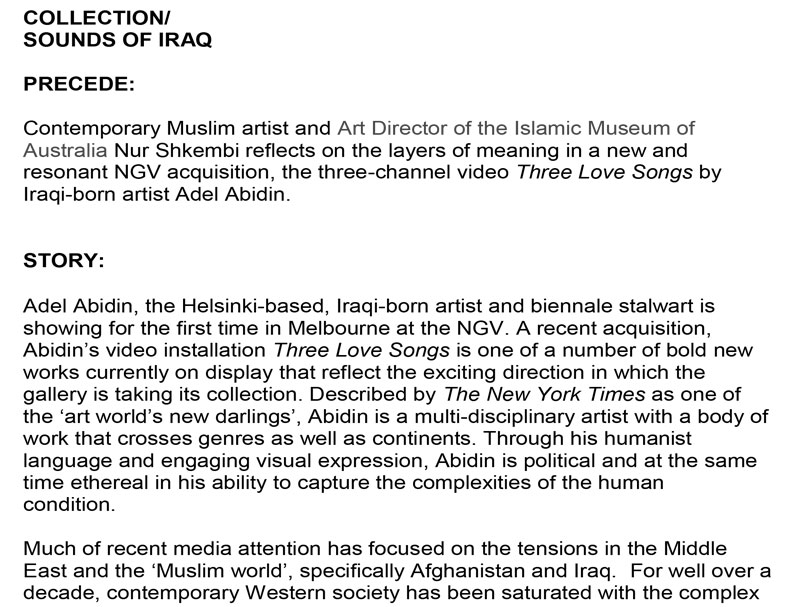
Adel Abidin, the Helsinki-based, Iraqi-born artist and biennale stalwart is showing for the first time in Melbourne at the NGV. A recent acquisition, Abidin’s video installation Three Love Songs is one of a number of bold new works currently on display that reflect the exciting direction in which the gallery is taking its collection. Described by The New York Times as one of
the ‘art world’s new darlings’, Abidin is a multi-disciplinary artist with a body of work that crosses genres as well as continents. Through his humanist language and engaging visual expression, Abidin is political and at the same time ethereal in his ability to capture the complexities of the human condition. Much of recent media attention has focused on the tensions in the Middle East and the ‘Muslim world’, specifically Afghanistan and Iraq. For well over a decade, contemporary Western society has been saturated with the complex political construct of the ‘war on terror’. Despite this overwhelming narrative of war, the face of the Muslim ‘other’ has rarely appeared in Australian public galleries, and until recently has been largely ignored. Abidin’s video installation occupies the largest of the darkened spaces specifically dedicated to video art on the third floor of the NGV International on St Kilda Road. It can be found at the end of a deliberated series of installations, new contemporary art acquisitions and the iconic Warhol selfportrait which demands your attention, as a Warhol usually does, on the way
into the space. There is enough ambiguity in Adel Abidin’s three-channel video installation Three Love Songs to offer both clarity and confusion. The familiar vision of the carefully crafted, ‘Western style’ female singer is presented as a cultural cliché, perhaps most fittingly described as the femme fatale trifecta: the sultry jazz singer, the cabaret artist and the pop diva. The videos are cleverly and unapologetically cynical – and embarrassingly hypnotic. But the genius of this installation is found not in the brightly sardonic imagery, but, rather, in the matter-of-fact translation considerately displayed at the bottom of the screen, in perhaps another act of sarcasm by the artist. But just as the lustful humour of the piece starts to beguile me, the meaning of the songs unfold and with them a sense of repulsion as I am reminded of the tragedy of Iraq. Abidin’s work points directly to Iraq’s past leader Saddam Hussein’s tyrannical
and oppressive rule by cleverly mocking the dictator’s propaganda songs. The songs are terribly written and one can hardly imagine the propaganda value in them beyond the notion of them grinding endlessly on the radio and into the public consciousness. But while Abidin takes a clear satirical swipe at Saddam, the West is certainly not left unscathed. The catastrophe of the Iraqi people bore all the hallmarks of Western powers mercilessly sustaining their consumerist lifestyle by guzzling the resources of Iraq. And yet, Abidin’s video sirens salute the Western dream while singing the praises of a dictator – their performance seems all too fitting in the political context of the Iraqi tragedy. There is a tepid brilliance about Abidin’s work; as an artist he critiques his own without losing himself. He is very human in his observations, perhaps almost
too human for those expecting either a ‘defector’ to applaud or an Arab ‘savage’ to detest, both conditions necessary for the affirmation of the
Occident and continuing justification for war. I watch as three young women who enter the space a moment after me are mesmerised by the young blonde pop singer moving seductively and sweetly
singing a Euro-style tune. Suddenly, the young women recoil in confusion and clear discomfort as the translation ‘by Allah we will level the enemy’s necks’ appears on the screen. I sit still, almost feeling guilty in my obvious Muslim attire; I see them glance over at me repeatedly and in that moment I illogically and frustratingly feel responsible for their discomfort. At that point, the ArabicIraqi dialect is just as foreign to me as it is to every other person present in the room, but I am immediately aware of the thread that ties me to the sentiment
those words bring. As with most great art, there are many layers and meanings; the poetry of the burdens and joys that can be found upon deeper contemplation, or indeed, more simply with an understanding of the personal story of the artist himself. Three Love Songs is no different in this regard, it has enough layers and entry points to deliver many messages. I stay on and observe as more visitors wander in and stop to watch the video then move around the screens, cautiously checking to see if there is anything else going on in the space. I decide at one point that the room is large, in fact much too large for the physicality of the installation which is contained to the three screens placed in proximity to each other. However, by the end of the second loop, it becomes clear to me that Abidin’s video installation moves well beyond its visual construct and is conceptually monumental. Also epic is the foresight of the NGV, under the directorship of Tony Ellwood, in acquiring and exhibiting the work. The space now feels right; perhaps the time is right also for the long overdue and difficult conversations that artists like Adel Abidin can invite to the table.
Source: Download PDF